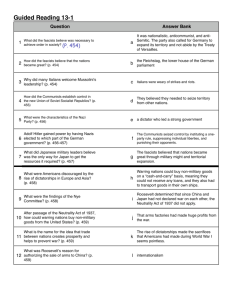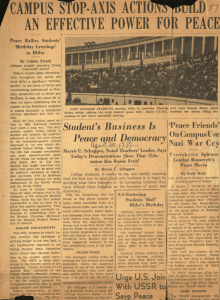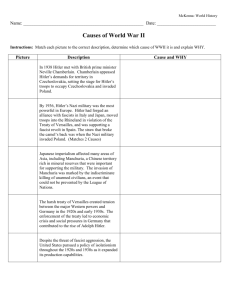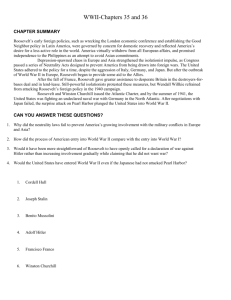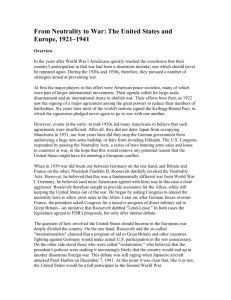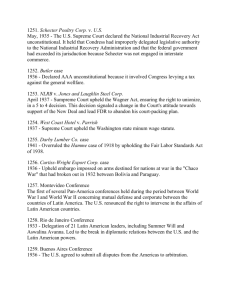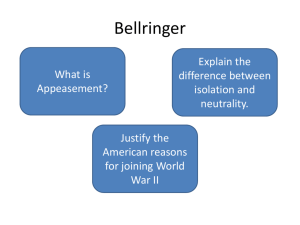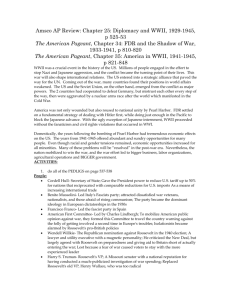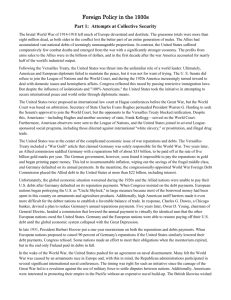13world war ii
advertisement
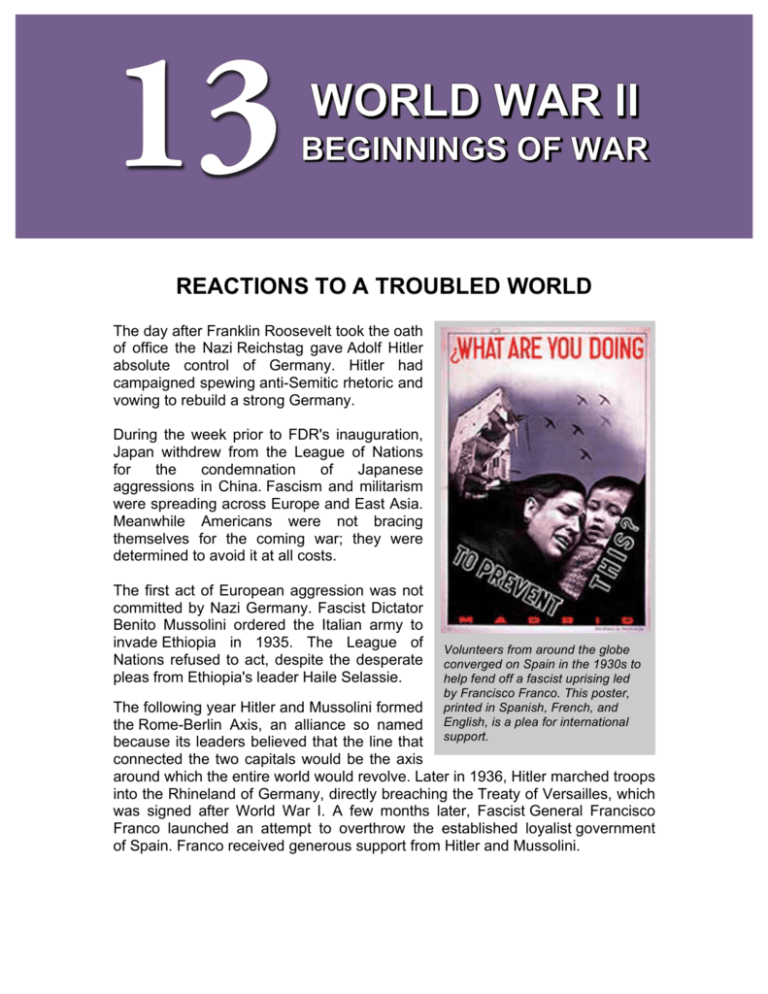
13 WORLD WAR II REACTIONS TO A TROUBLED WORLD The day after Franklin Roosevelt took the oath of office the Nazi Reichstag gave Adolf Hitler absolute control of Germany. Hitler had campaigned spewing anti-Semitic rhetoric and vowing to rebuild a strong Germany. During the week prior to FDR's inauguration, Japan withdrew from the League of Nations for the condemnation of Japanese aggressions in China. Fascism and militarism were spreading across Europe and East Asia. Meanwhile Americans were not bracing themselves for the coming war; they were determined to avoid it at all costs. The first act of European aggression was not committed by Nazi Germany. Fascist Dictator Benito Mussolini ordered the Italian army to invade Ethiopia in 1935. The League of Nations refused to act, despite the desperate pleas from Ethiopia's leader Haile Selassie. Volunteers from around the globe converged on Spain in the 1930s to help fend off a fascist uprising led by Francisco Franco. This poster, printed in Spanish, French, and English, is a plea for international support. The following year Hitler and Mussolini formed the Rome-Berlin Axis, an alliance so named because its leaders believed that the line that connected the two capitals would be the axis around which the entire world would revolve. Later in 1936, Hitler marched troops into the Rhineland of Germany, directly breaching the Treaty of Versailles, which was signed after World War I. A few months later, Fascist General Francisco Franco launched an attempt to overthrow the established loyalist government of Spain. Franco received generous support from Hitler and Mussolini. While Fascist aggressors were chalking up victories across Europe, America, Britain, and France sat on the sidelines. The desire to avoid repeating the mistakes of World War I was so strong, no government was willing to confront the dictators. Economic sanctions were unpopular during the height of the Great Depression. The Loyalists in Spain were already receiving aid from the Soviet Union; therefore, public opinion was against assisting Moscow in its "private" war against fascism. As the specter of dictatorship spread across Europe, the West feebly objected with light rebukes and economic penalties with no teeth. Pablo Picasso created this mural for display in the Spanish Pavilion at the 1937 World's Fair. Entitled "Guernica," it depicts the slaughter of over 1,600 Spanish civilians by fascist forces. The United States Congress and President Roosevelt passed three important laws — all called Neutrality Acts— directly aimed at reversing the mistakes made that led to the American entry into the First World War. The Neutrality Act of 1935 prohibited the shipping of arms to nations at war, including the victims of aggressions. This would reduce the possibility of maritime attacks on American vessels. A Senate Committee led by Gerald Nye had conducted extensive research on US activities prior to World War I concluded that trade and international finance had been the leading cause of American entry. The Neutrality Act of 1936 renewed the law of the previous year with the additional restrictions — no loans could be made to belligerent nations. Nor were any Americans permitted to travel on the ships of nations at war. There would be no more Lusitania incidents. A Neutrality Act of 1937 limited the trade of even non-munitions to belligerent nations to a “cash and carry basis." This meant that the nation in question would have to use its ships to transport goods to avoid American entanglements on the high seas. Isolationists in Congress felt reasonably confident that these measures would keep the United States out of another war. The Neutrality Act of 1936 was designed to keep American citizens out of peril by forbidding them to travel on the ships of warring nations. More than 100 Americans were killed when a German submarine torpedoed the Lusitania in 1915. But as the decade passed, President Roosevelt was growing increasingly skeptical. WAR BREAKS OUT On July 7, 1937, a skirmish between Chinese and Japanese troops broke out at the Marco Polo Bridge near Beijing. The cause of the fracas is unknown, but the Japanese government used it as a pretext to launch a full-scale invasion of China. Hoping to deliver a quick knockout punch, the Japanese furiously bombed Chinese cities and advanced with their better-equipped army. Despite enduring heavy losses, the Chinese regrouped in the interior of their vast land and mounted an entrenched resistance. Reports of the "Rape of Nanking," the sacking of the Chinese capital reached the American mainland in the summer of 1937. The brutalities prompted President Roosevelt to abandon cooperation with Congressional isolationists to pursue a more forceful approach against the Japanese. German troops parade through Warsaw in September 1939 following their invasion of Poland. Britain and France responded to this action with declarations of war against Germany. World War II was officially underway. In October 1937, he delivered his famous Quarantine Speech in Chicago. For the first time, Roosevelt advocated collective action to stop the epidemic aggression. But his hopes of igniting American sensibilities failed. Even when a Japanese plane bombed the USS Panay on December 12, there was no cry for a response. The Panay had been stationed in China on the Yangtze River. Japan apologized and paid an indemnity and the incident was soon forgotten, despite the loss of three American lives. Compared to the public response to the sinking of the Maine in 1898, the American people hardly mustered a whisper. Emboldened by western inaction, Hitler's troops marched into Austria in 1938 and annexed the country. Then Hitler set his eyes upon the Sudetenland, a region in western Czechoslovakia inhabited by 3.5 million Germans. In September the leaders of Britain, France, Germany, and Italy met in Munich attempting to diffuse a precarious situation. Britain and France recognized Hitler's claim to the Sudetenland and Mussolini's conquest of Ethiopia in exchange for the promise of no future aggressions. Prime Minister Neville Chamberlain returned to Great Britain triumphantly proclaiming that he had achieved "peace in our time." It would be one of the most mocked statements of the 20th century. This map of Czechoslovakia shows the fierce land-grabbing that took place in the Fall of 1938. Hungary, Germany, and Poland all managed to claim a piece as their own. European appeasement failed six months later, as Hitler mockingly marched his troops into the rest of Czechoslovakia. In May 1939, Roosevelt urged Congressional leaders to repeal the arms embargo of the earlier Neutrality Acts. Senators from both parties refused the request. Another bombshell crossed the Atlantic on August 24. Adolf Hitler and Josef Stalin agreed to put their mutual hatred aside. Germany and the Soviet Union signed a tenyear Nonaggression Pact. Hitler was now free to seize the territory Germany had lost to Poland as a result of the Treaty of Versailles. On September 1, 1939, Nazi troops crossed into Poland from the west. Finally, on September 3, France and Great Britain declared war on Germany. World War II had begun. from USHistory.org

